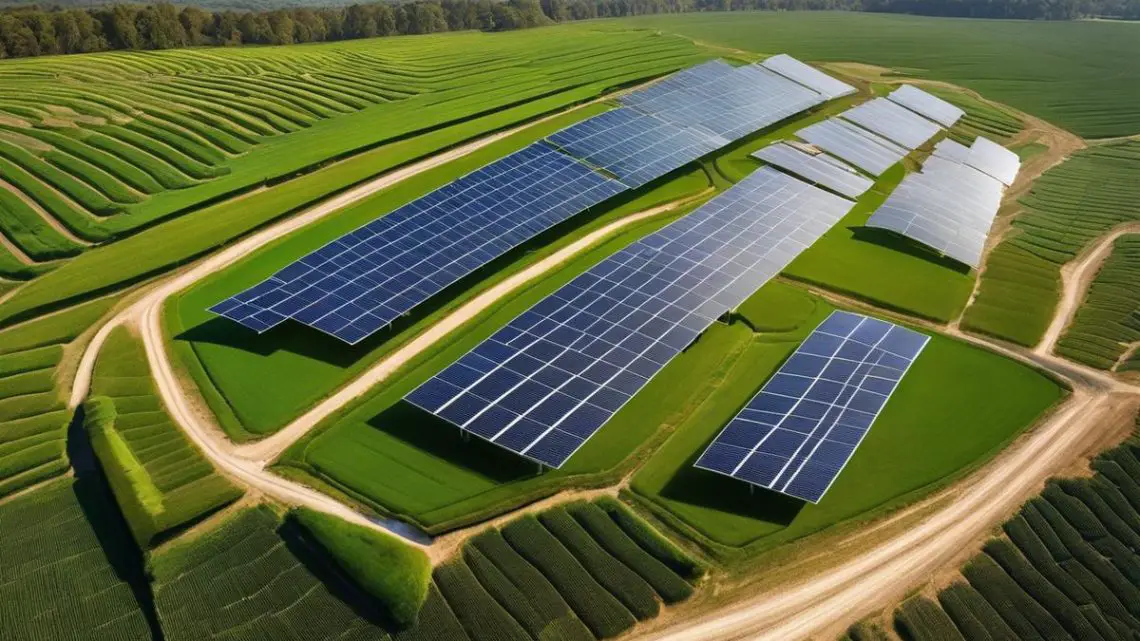
How to Start a Solar Farm Business and Max Your Income
February 15, 2024As the surge in renewable energy initiatives continues to redefine the landscape of energy production, solar farming has emerged as a beacon of sustainable income and environmental stewardship. The economics of solar farming is a multifaceted domain, shaped by a variety of revenue streams, encompassing energy production, tax incentives, and an evolving market influenced by geography and policy. Coupled with a closer look at land efficiency and the judicious use of space for maximal energy harvest, solar farms present an intricate tapestry of economic potential and ecological consideration.
As we delve into the complexities of financing solar ventures and navigate the intricate web of regulations that govern them, we uncover the robust frameworks and challenges that await the enterprising investor or environmentally conscious landowner. This exploration seeks to illuminate the path toward a greener future and a prosperous venture in the realm of solar energy.
Economics of Solar Farming – A Growing Small Business Trend
When it comes to investing in renewable energy, few opportunities shine as brightly as solar farm land. The Return on Investment (ROI) for solar energy is a convincing narrative of modern economics, combining sustainability with profitability. With the insatiable global demand for cleaner energy solutions, solar farm land investment is no longer just an environmental statement; it’s a robust financial strategy.
The striking aspect of solar farm land ROI lies in both its immediate and long-term financial benefits. In the short run, investors enjoy tax benefits, grants, and incentives such as the Investment Tax Credit (ITC), which can cover a substantial portion of the total project cost. But the real magic happens over time. Once operational, solar farms sell the generated electricity, often at fixed prices via Power Purchase Agreements (PPAs), yielding steady cash flows. As sunlight is free and operational costs are predictable, profit margins can be impressively high. A typical solar farm can offer a ROI that spans anywhere from 10% to 20% annually, contingent on factors like location, size, and local energy prices.
The beauty of solar farm investments is their dual impact. While financially lucrative, they also demonstrate a commitment to a more sustainable future, aligning investors with the tide of consumer sentiment and regulatory focus. The time is ripe to diversify portfolios to include solar – anticipate the trends, ride the wave of clean energy, and watch as the once-sleepy farmlands transform into gold mines of the green economy.

Land Use & Efficiency – How Much Land Do You Need for a Profitable Solar Farm?
As a seasoned entrepreneur, one grasps that successful business ventures are as much about precision in planning as they are about spotting the opportunity. So, when it comes to calculating the land needed for a profitable solar farm, a few key considerations must guide the process.
A solar farm’s profitability is strongly tied to its capacity, which is expressed in megawatts (MW). Commercial solar farms typically start at 1 MW, requiring approximately 4 to 5 acres of land. However, to hit the sweet spot of economies of scale and maximize returns, larger farms tend to be more cost-efficient. This scale is achieved at around 5 MW, which requires 25 to 30 acres. For optimal utilization, investors must secure enough acreage to accommodate not just solar panels, but also for infrastructure like access roads, maintenance facilities, and buffer zones.
Projecting Earnings from an Acre of Solar Farm
To forecast the possible earnings from a solar farm, it’s imperative to consider the initial capital investment, ongoing operational expenses, and the revenue obtained from selling the electricity generated.
The financial gain per acre of solar panels can significantly differ due to factors like local electricity tariffs, government incentives, and the efficiency of the installed solar panels.
Industry estimates indicate that a solar farm may yield an annual income ranging from $21,250 to $42,500 per acre. Nonetheless, these figures are subject to change, depending on the unique conditions of each individual solar farm.
Navigating through zoning laws and land use regulations is paramount. Not all acres are created equal—a savvy entrepreneur must target land with the right attributes: low-cost, minimal shading, proper inclination, and most importantly, access to solar resources. Proximity to power grids is another non-negotiable—without it, the solar farm’s potential remains untapped. By strategically selecting land that checks these boxes, profitability is not a mere possibility, it’s a well-planned outcome.
In summary, there is no one-size-fits-all answer to land requirements. Each solar farm project must be meticulously planned, considering the minimum efficient scale and regulatory landscape to ensure a venture that shines bright in both returns and sustainability.

Financing & Investment – Unlocking the Potential of Solar Farms: A Guide to Financing Options
When exploring financial models to fund a solar farm, understanding and leveraging the power of financing options is a pivotal step. Equity financing is a cornerstone, bringing together individuals or entities willing to exchange capital for a portion of ownership in the solar project. This path taps into a pool of investors seeking sustainable and environmentally-conscious opportunities and often leads to strong alliances with like-minded stakeholders who are ready to champion renewable energy initiatives.
Another pathway is debt financing, where securing loans or issuing bonds can fuel the capital needed for solar farm construction and operations. Financial institutions are increasingly recognizing the stable revenue stream of solar farms, offering more competitive rates for green projects. Securing debt financing commonly hinges on the project’s bankability, which is directly affected by the precision of planning, capacity potential, and strategic land selection, as mentioned earlier.
Lastly, innovative financial models like solar leases and power purchase agreements (PPA) are disrupting traditional funding mechanisms. These alternatives shift the financial burden from the solar farm developer to third parties that, in exchange, benefit from predictable energy costs or investment returns over time. With these models, upfront capital requirements are significantly reduced, thus lowering barriers to entry.
Harnessing the right mix of equity, debt, and innovative financing tools is critical. Effortlessly blending these can optimize capital structure, mitigate risks, and ensure the robust financial health of a solar farm project – ultimately brightening the path to a renewable future.

Regulatory Environment – Government Policies and Their Impact on Solar Farm Profits
When diving into the intricacies of government policy impacts on solar farm profits, an astute entrepreneur recognizes the vital role that such policies play. It’s not merely about the immediate advantages but about understanding and utilizing the policy landscape to safeguard long-term gains and operational efficiency. Government policies can significantly influence both the establishment and expansion of solar farms by crafting an environment conducive to investment and growth.
One key consideration lies within the realm of regulatory shifts. Solar farms operate within a dynamic regulatory context that includes not only incentives but also compliance costs. For instance, a change in environmental regulations could require additional investment in technology to meet new standards, thus affecting profitability. Smart business planning entails keeping a finger on the pulse of policy changes to anticipate and adapt to potential cost implications swiftly.
Furthermore, policies related to energy buyback rates play a critical role in financial projections. Solar farms depend on favorable feed-in tariffs and net metering policies that determine how much utility companies pay for the surplus energy fed back into the grid. A sudden policy swing in this area could make the difference between a decent return on investment and a highly lucrative one. The savvy entrepreneur must engage policymakers and leverage their professional network to influence the trajectory of such regulations favorably.
In essence, the ability to navigate the policy landscape is as crucial as the physical infrastructure of the solar farm itself. Entrepreneurs who integrate policy awareness into their strategic planning are the ones who reap the benefits of a well-oiled profit machine, capable of weathering policy storms and capitalizing on regulatory tailwinds.

The journey through the intricacies of solar farming underscores a critical intersection of economic savvy, environmental responsibility, and innovative financing strategies. With the landscape of governmental support and policy continuously evolving, staying abreast of the most current regulations and incentives is key to harnessing the full potential of solar farm investments. Whether maximizing the utility of each acre or forging partnerships that bolster the financial bedrock of solar endeavors, the careful orchestration of these elements is vital to the sustainability and profitability of solar farms. As the sun continues to rise on renewable energy, it heralds a promising horizon for those prepared to invest in the solar economy and cultivate a legacy of clean energy for generations to come.



 HFN News is your leading source for fresh hydrogen and renewable energy updates. Amid the fast-paced growth of hydrogen companies, we provide top-notch news and insights about this exciting sector. Our coverage spans from hydrogen cars to global sustainable initiatives, and we highlight the latest in green jobs and developing hydrogen hubs. We invite you to share your local hydrogen news and explore today’s renewable energy job listings on our site. Thanks for choosing HFN News as your trusted guide to the hydrogen and renewable energy world!
HFN News is your leading source for fresh hydrogen and renewable energy updates. Amid the fast-paced growth of hydrogen companies, we provide top-notch news and insights about this exciting sector. Our coverage spans from hydrogen cars to global sustainable initiatives, and we highlight the latest in green jobs and developing hydrogen hubs. We invite you to share your local hydrogen news and explore today’s renewable energy job listings on our site. Thanks for choosing HFN News as your trusted guide to the hydrogen and renewable energy world!